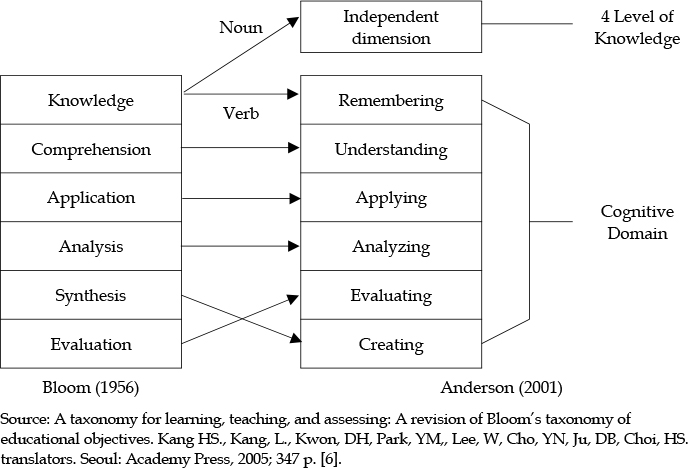J Korean Acad Nurs Adm.
2019 Jun;25(3):198-207. 10.11111/jkana.2019.25.3.198.
Analysis of Knowledge in Nursing Management Educational Objectives based on Anderson's Revision of Bloom's Taxonomy
- Affiliations
-
- 1Department of Nursing, Daegu Health College, Korea.
- 2Department of Nursing, Dong-eui University, Korea. deukmj@deu.ac.kr
- KMID: 2451696
- DOI: http://doi.org/10.11111/jkana.2019.25.3.198
Abstract
- PURPOSE
The purpose of this study was to analyze the Nursing management educational objectives and nurse duties required to be achieved in the nursing management curriculum in nursing job analysis.
METHODS
Nursing management educational objectives and knowledge to be achieved in a nursing management curriculum in nursing job analysis were analyzed using Anderson's Revision of Bloom's taxonomy of Educational Objectives.
RESULTS
The analysis showed that 172 (59.3%) of the 290 educational objectives of the nursing management corresponded to "˜conceptual knowledge' and 167 (57.6%) of the "˜cognitive process dimension' were "˜understanding'. In the job analysis, 29 out of 57 (50.9%) were procedural knowledge. The finding indicates that "˜health promotion and maintenance' duty was excluded from the job analysis, but included in the nursing management curriculum and objectives.
CONCLUSION
The results of this study contribute to the foundation of nursing management as a practical study by analyzing the goal of nursing management learning in connection with the job analysis required in the field.
MeSH Terms
Figure
Reference
-
1. Tyler RW. Basic principles of curriculum and instruction. Chicago, IL: University of Chicago Press;1969.2. Bloom BS, Engelhart MD. Taxonomy of educational objectives: the classification of educational goals. Handbook 1. Cognitive domain. New York: Longmans, Green;1956.3. Krathwohl DR, Bloom BS, Masia BB. Taxonomy of educational objectives: the classification of educational goals. Handbook 2. Affective domain. New York: Longmans, Green;1956.4. Simpson EJ. The classification of educational objectives: psychomotor domain. Urbana-Champaign, IL: University of Illinois;1966.5. Harrow AJ. A taxonomy of the psychomotor domain.: A guide for developing behavioral objectives. New York: David McKay;1972.6. Anderson LW, Krathwohl DR. HS Kang L Kang DH Kwon YM Park W Lee YN Cho DB Ju HS Choi . A taxonomy for learning, teaching, and assessing: A revision of Bloom's taxonomy of educational objectives. Seoul: Academy Press;2005.7. Korean Academy of Nursing Administration. Nursing management educational objectives [Internet]. Seoul: Korean Academy of Nursing Administration;cited January 3, 2017. Available from:http://www.kanad.or.kr/index.php?page=view&pg=&idx=81&hCode=BOARD&bo_idx=1&sfl=&stx=.8. Park SA, Jung MS, Kim JH, Kim JK, Joo MK, Park SH, et al. Nursing management: nursing business and policy. Paju: Koonja;2010.9. Park IS. Research report of 2nd job description of nurses. Report, vol RE3-1210-05. Seoul: Korea Health Personnel Licensing Examination Institute;2012.10. Yang JS, Lee GS. Analysis of knowledge and competency for the fourth industrial revolution based on Anderson's revision of Bloom's taxonomy: Focused on achievement standard in the 2015 revised practical arts (Technology · Home Economics). Journal of Korean Home Economics Education Association. 2018; 30(3):129–149. DOI: 10.19031/jkheea.2018.09.30.3.129.11. Yuk KM, Cho HJ. Analysis of the lesson goals in technology-home economics textbooks according to the revised National Curriculum of 2007. Secondary Education Research. 2011; 59(4):913–938.12. Choi JI, Paik SH. A comparative analysis of achievement standards of the 2007 & 2009 revised elementary science curriculum with next generation science standards in US based on Bloom's revised taxonomy. Journal of the Korean Association for Science Education. 2015; 35(2):277–288.13. Lee MJ, Lee GS, Yoo TM. Analysis of home economics textbooks of 2007 revised curriculum based on 'A revision of Bloom's taxonomy of educational objectives'. Journal of Korean Practical Arts Education. 2011; 17(2):149–176. DOI: 10.17055/jpaer.2011.17.2.149.14. Bandura A. Self-efficacy: the exercise of control. New York: W. H. Freeman;1997.15. Marzano RJ. Designing a new taxonomy of educational objectives. Thousand Oaks, CA: Corwin Press;2001.
- Full Text Links
- Actions
-
Cited
- CITED
-
- Close
- Share
- Similar articles
-
- A Comparison of Learning Objectives in Fundamentals of Nursing between 2000 and 2004 year
- Retrospective analysis of prevalent anatomy spotter's examination: an educational audit
- Comparison of the level of cognitive processing between case-based items and non-case-based items on the Interuniversity Progress Test of Medicine in the Netherlands
- Educational needs for the development of a simulation module of home visiting care for the frail elderly
- Educational goals and objectives of nursing education programs: Topic modeling


